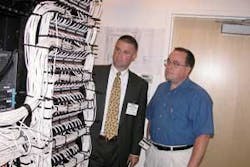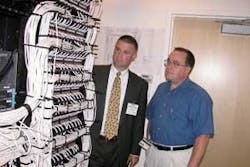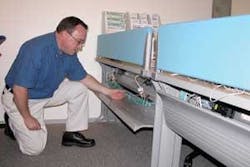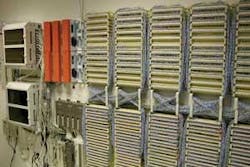Meticulously planned and executed construction of Genzyme Corp.’s communications systems allows information sharing among 6,300 workers.
The Genzyme Corporation’s (www.genzyme.com) cutting-edge headquarters in Cambridge, MA reflects a forward-thinking company’s vision for being a global leader in biotechnology, dedicated to making a major impact on the lives of those who are suffering with serious diseases.
Not only is the 12-story, 350,000-square-foot Genzyme Center an expression of key core values that have driven the company’s success-innovation, transparency, and collaboration-but it is also expected to become the country’s largest building to be certified at the platinum level by the United States Green Building Council’s LEED (Leadership in Energy and Environmental Design) rating system.
Genzyme Center was carefully designed from the inside out to provide an ideal working environment-and that included communications.
Occupied in late 2003, the center combines a bold design with state-of-the-art technology to create a highly functional workplace for nearly 1,000 employees. The building’s glass exterior and 12-story central atrium allows natural light to flood the interior. On the roof, heliostats (sophisticated mirrors) track the path of the sun and reflect sunlight onto an opposing set of mirrors that direct it through the top of the atrium and onto specially reflective suspended panels. Reminiscent of giant artistic mobiles, these panels reflect the natural light into the workspace on each floor from the interior of the building, while the glass exterior allows additional sunlight to penetrate the building.
Communication by design
Shared ideas and information are the lifeblood of Genzyme. Founded in Boston in 1981, its 6,300 employees occupy approximately 40 buildings in New England and several other buildings throughout the world-all connected by an Ethernet network.
The Genzyme Center is designed first to enhance communication by encouraging informational meetings in the building’s common spaces, garden areas, and top-floor cafeteria (with its sweeping views of the Boston cityscape).
Various center terraces, corners, and walkways are built to encourage spontaneous conversation. Offices are purposely small while the amount of common space is much greater than what is typically found in an American office building. Transparent office walls invite colleagues in. The result: a higher level of interaction, collaboration, and creativity.
Equally important to enabling exchange and interaction is the structured cabling system that serves the center and links it with Genzyme’s other global sites.
John Ziroli, Genzyme’s information-technology director of network operations, says that’s why the company opted for the NetClearGT2 enhanced Category 6 solution, offered by Berk-Tek, a Nexans Company (www.berktek.com), and Ortronics (www.ortronics.com), for horizontal cabling to work areas. They also chose a combination of Berk-Tek’s GIGAlite-10 enhanced 50-micron (µm) multimode fiber and singlemode fiber for backbone cabling.
Among the most important requirements for structured cabling, says Ziroli, were futureproofing, security, and warranty. NetClear systems carry a 25-year warranty.
“I’m very pleased,” Ziroli says. “We haven’t had one issue and we have just under 1,000 users. The project was virtually seamless and we didn’t have to worry about micromanaging. I came out looking like a hero.”
Forethought and forward thinking
Much planning went into making the system perform smoothly. Tom Sullivan, vice president of Uxbirdge, MA-based Corporate Communication Services-the project’s installation contractor-says his firm got involved in the planning process about a year before installation began in December 2002. “This was a well-planned part of the center, which is how Genzyme works,” notes Sullivan. Corporate Communications installed more than one million feet of Berk-Tek LANmark-1000 cable for the project.
Genzyme has been a Corporate Communications client since 1984, when the contractor installed voice and data systems and an early Mac network at the company’s Framingham, MA building. “They’re our largest client and always have something going on,” Sullivan says. Corporate Communications won the Genzyme Center project through competitive bidding.
“The NetClearGT2 solution gives Genzyme guaranteed installed channel performance 2 dB above all Category 6 crosstalk and return-loss requirements, and a system that is free from bit errors caused by the structured cabling plant-a key because Genzyme is looking for maximum network reliability,” Sullivan explains. “Bandwidth, availability, and the warranty were further advantages.”
The NetClearGT2 solution includes Berk-Tek’s LANmark-1000 Category 6 UTP cable and Ortronics’ Clarity 6 connectivity, both of which Corporate Communications has used for several years. “LANmark-1000 is very close to the same diameter as Category 5e,” says Sullivan. “Other Cat 6 cabling is too big. LANmark-1000 is consistent in size and very easy to adapt. It’s easy to terminate.”
Each workstation in the Genzyme Center has three color-coded data and/or voice terminations and its own unique seven-digit location number. “There is no duplication of workstation numbers at any global Genzyme location, which makes it much easier to troubleshoot,” Sullivan says.
Like Genzyme, Corporate Communications believes in consistency. “Instead of just running a wire, for example, we install a standard station,” says Sullivan. “It doesn’t matter which building you’re in; all the stations are the same. Everything is numbered in order in the closets, too. We maintain an electronic database for all locations.
Sullivan notes, “Too many companies keep their cabling-plant numbering organized based on the station location on the floor, instead of the port location in the closet,” which can cause confusion for technicians searching for a station location that may be out of order in the closet. “[Now,] the person calling in for help knows where they are.”
High-bandwidth fiber considerations
Initially, Genzyme specified 62.5-µm fiber for backbone cabling, but Ziroli discovered Berk-Tek’s 50-µm GIGAlite-10 optical fiber when he attended a BICSI conference. “I asked Tom Sullivan about it and to satisfy my curiosity, he and Brian Hendrick from CSC [Communications Supply Corp.; www.gocsc.com], our distributor, arranged a tour of the OFS (www.ofsbrightwave.com) fiber-manufacturing facility” in Sturbridge, MA. Optical-fiber manufacturer OFS and Berk-Tek have worked together to bring to market 50-µm multimode fiber technology that claims the highest bandwidth in the industry. GIGAlite-10 cable achieves 2,000 MHz•km bandwidth at 850 nanometers (nm) and 500 MHz•km bandwidth at 1310 nm. “That tour convinced me to go with 50-µm GIGAlite-10,” Ziroli recalls.
“During the tour, we were impressed by the state-of-the-art OFS facilities and tightly controlled manufacturing process used to produce enhanced 50-µm multimode fiber,” Ziroli continues.
The process guarantees the tightest differential mode delay profile in the industry, OFS says. As a result, GIGAlite-10 optical fiber offers significant bandwidth and reach advantages for 1-Gbit/sec and 10-Gbit/sec applications, while preserving the low system-cost advantages of multimode fiber. GIGAlite-10 fiber guarantees Gigabit Ethernet transmission to 1,000 meters, and 10-Gigabit Ethernet performance to 300 meters.
Sullivan says the Genzyme Center’s cabling plant has fiber running from its main crossconnect to Cisco servers in the intermediate crossconnects on each of the 12 floors. While closet space is always at a premium, Genzyme provided sufficient room to meet current and future demand.
“We ran six strands of singlemode and 12 strands of multimode,” Sullivan says. “We decided to use Berk-Tek’s ArmorTek interlock armor cable for the backbone instead of plenum innerduct or conduit. That allowed us to save about 25% on labor and about 15% on materials because it was only one pull.” He added that armored cable will give Genzyme maximum flexibility for future relocations and design changes, which is something neither plenum innerduct nor conduit provides.
Ziroli said the singlemode fiber will accommodate the possible addition of other buildings to the network.
Corporate Communications also installed cable for other communications technologies, including flat-screen televisions in the conference rooms and common areas as well as the cabling plant that handles the controls for the building’s sophisticated natural-light distribution system.
While the cabling-plant installation was fairly standard, Sullivan says one problem was trying to fit the cabling and trays, which Corporate Communications did not install, into a tightly packed ceiling. The close quarters were due to the uniqueness of the heating/ventilating/air-conditioning system. “For example,” explains Ziroli, “there are no large roof air-conditioning units. There are a lot of smaller condensers located throughout the building to be able to control heating and cooling more economically using smaller zones. The ceilings are higher throughout.”
For Genzyme and Ziroli, the center’s cabling plant is exceeding expectations: “Everyone involved made it work by going the extra mile to bring it in on time and within budget. I liked that [Brian] Hendrick called me periodically to make sure everything was OK. We all appreciated CSC’s ability to quickly accommodate change requests since there were a number of last-minute changes. ”
Ziroli stresses, however, “What’s really important is that we’re ahead of the future. We believe we have seven years before we have to make a change.”
TODD HARPEL, RCDD, is director of marketing for Berk-Tek (www.berktek.com). He has more than 14 years’ experience in marketing, sales, and communications-cabling infrastructure design and specification. F. ALAN SHIRKis president of Shirk Communications (www.shirkcom.com), an advertising and public relations agency.



